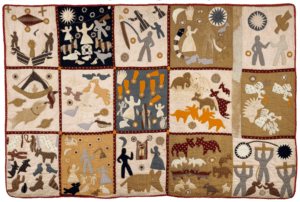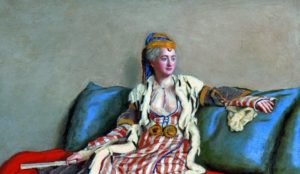United States Navy nurse Margaret Nash was a woman of resilience and courage. Captured and held as a prisoner of war by the Japanese during World War II, she neglected her own health to nurse hundreds of her fellow prisoners suffering from disease and near-starvation in the Philippine Islands. She was still struggling to survive when the camp was finally liberated by US forces three years later. Though doctors told her she wouldn’t survive, she went on to live a long life nursing and teaching.
In early December 1941, U.S. Navy Nurse Margaret Nash waited at Cavite Naval Base in the Philippines for her fiancé to arrive aboard the U.S.S. Penguin. She planned their wedding for the coming Valentine’s Day.
Less than a month later, Margaret was a prisoner-of-war, captured by the Japanese. She would suffer terror, illness and near-starvation more than three years before her liberation, and she would not hear a word about her fiancé for nearly four years.
Margaret was one of eleven U.S. Navy nurses captured in Manila in January 1942. They were allowed to continue to nurse wounded American servicemen for a short time before the Japanese whisked them away from their patients to Santo Tomas Internment Camp. The Navy nurses set up a small hospital in the civilian camp and offered medical care to other prisoners, who were citizens of Allied countries unable to escape before American-Filipino forces surrendered the Philippines to Japan.
Conditions were tolerable for the first year, until more captives were brought into the crowded camp. When the Japanese opened another POW camp at Los Baños in a rural area outside Manila, Margaret and the other Navy nurses volunteered to go there and set up a hospital. Arriving in Los Baños, Margaret heard the birds sing and enjoyed the fresh country air. The Japanese billed Los Baños as a health resort, but conditions were primitive and the prisoners were expected to grow their own food. Vegetables flourished in the fertile soil, but more and more prisoners transferred into the camp.
Margaret said later the women were not beaten or tortured in the strictest sense, but did suffer intense emotional strain. “The Japanese guard would walk in our quarters at any hour of the day or night. This caused much distress because we never knew what they had in mind, and we never stayed alone in a room and kept our clothes on at all times,” she said.
By 1944 Margaret and the others were losing weight and suffering malnutrition. Nurses became mentally and physically exhausted from working at the hospital. The Japanese guards became more brutal, shooting any prisoner caught going over the camp fence in search of food.
Eventually, the inmates were reduced to eating leaves and even digging up loathsome slugs for food. “We’d look outside the fence and see monkeys in the banana trees,” Margaret said later. “We’d see them peel bananas. We stared at them. We were really starving.”
The hospital filled with patients suffering malnutrition and then the deaths began. Margaret grew as sick as her patients. Her legs and arms puffed with fluid, symptoms of beriberi, a disease caused by lack of vitamin B. Weak and short of breath, with a temperature of 106 F, Margaret soon lay in one of her own hospital beds.
Lacking proper food and medicine, it was a miracle Margaret survived, but eventually she was back on her feet.
We kept taking care of patients, though we were all getting weaker. I was getting to the point I would look at a pair of steps and I’d think, I can’t walk up, and neither could anyone else. You never knew when you went to bed at night, if you’d wake up.
How many died, I’ll never know. Two or three would die every day. One would say to another, ‘If you think you’re going to die, you better start digging your grave because I am just too weak.’
In September 1944, U.S. forces landed in Leyte and started to liberate the Philippines, but by Christmas it was clear the prisoners might not survive long enough to be rescued. The first week of February 1945, American forces broke down the gates at Santo Tomas where Margaret had initially been imprisoned. They liberated the camp, including 68 Army nurses captive there.
The news leaked into Los Baños, but days turned into weeks and Margaret feared Americans did not know the camp existed. The Japanese army controlled the region and soldiers set machine guns in a ring around the camp. By February 21, the inmates ate the last remaining rice and a rumor swept through—the Japanese planned to execute them all.

Perhaps just minutes before the guards at Los Baños slaughtered the navy nurses and some 2000 prisoners, including many children, American soldiers and Filipino Guerillas commenced with a three prong operation. Amphibious tanks, ground forces and paratroopers launched an assault to liberate the camp.
The entire operation was over in less than 15 minutes, and soldiers rushed inmates away from the camp, hauling them in the amphibious tanks across the nearby Laguna de Bay to U.S. held territory. Margaret was carried from the camp on a stretcher, though at work in the hospital when paratroopers landed, she had dropped to a mere 68 pounds.
Navy nurses were flown back to the states and given leave to recuperate and visit their families. But Margaret was too sick to go home. A month later she was allowed a short visit with her mother, who was also in poor health, but then admitted to a tuberculosis sanitarium. Doctors gave Margaret five years to live.
“I was determined not to die,” she said. But when news came months later that her fiancé had also been liberated from POW camp, Margaret thought it only fair to break off the engagement. She retired from the navy with the honorary rank of Lieutenant Commander and was awarded the American Defense Service Medal with one bronze star, the Asiatic-Pacific Area campaign medical with one bronze star, the Army Distinguished Unit Badge with Oak Leaf cluster and the Philippine Defense Ribbon.
After a long period of recuperation, Margaret began to teach nursing at the University of California, Berkeley where she worked until 1973. She continued to live a full life, volunteering to care for senior citizens in their homes and spending time with her nieces and nephews. Margaret died at age 81.
The 79 Army and Navy nurses held captive in the Philippines for the length of WWII did not receive recognition for their sacrifice and service until 1983 when the group was honored at a National POW/MIA Recognition Day at the White House. Their story is told in the new book PURE GRIT: How American World War II Nurses Survived Battle and Prison Camp in the Pacific.

Featured image: U.S. Navy Nurse Margaret Nash at work in Santo Tomas Internment Camp Hospital (Japanese propaganda photo)
PURE GRIT: How American World War II Nurses Survived Battle and Prison Camp in the Pacific is the newest book of award-winning journalist and author Mary Cronk Farrell.





Thanks so much for including my article on Amazing Women of History. Margaret Nash is a great inspiration to me and I hope she will inspire others as well.
An amazing story. I wonder, did she ever meet her fiance again? How wonderful she lived to a grand old age after being given just 5 years to live.
Edward, I’m sorry I didn’t see your question before this. It’s been a wild summer. Peggy did not see her fiance until late 1945 or 46. He had been a POW of the Japanese for the entire war and had survived extremely brutal treatment and harsh conditions. I got into more detail in my book, mentioned above, but I will tell you that she ended up not marrying him.
What a incredible story of service, compassion and strength. Thank you for sharing Margaret Nash’s story, and for this wonderful website. I have two young girls, and I will be sharing these stories with them. Thank you!
Thanks for dropping by and sharing your thoughts. Yes, Kari does a great job with this website offering us so many examples of courageous women in all walks of life.
Wow, this is just incredible. I am so glad to have found this website today and hear the stories of amazing women in history. There are so many more that need to be told. Women have and will continue to do so much more than have babies and cook dinner. Keep telling their stories! Keep encouraging all girls and women to dream big and live remarkable lives.
Thanks for sharing your thoughts, Beth Anne. So nice to know someone is out there reading. 🙂
Awesome!! I am so glad I found your blog! I recently started my own blog seeking to share women throughout history, and eventually women in today’s world. I would love it if you would take the time to check it out! http://realwomenhavepower.blogspot.com
Like I said, I just started it, and am not a pro at this, so it isn’t much yet, but I am working on it.
My Great uncle Leo Cullum was a Jesuit priest interned in Los Banos at the same time
Family stories tell that he,t 6’3″ ,was about 90 lbs when rescued and fell in the water. Had one to the rescuing soldersnot plucked him out he would surly have drowned. he spent a total of 63 years in the Philippines and died there at the age of 86 in 1986.
The courage of Margret Nash brings it all back
I have just seen the movie paradise road, and I am overwhelmed and saddened that i was not aware of all the women pow’s in WWII.. I plan to read your book, as well troll the internet for more information.. I am in awe of the women who survived and heartbroken that this part of the war is not apparent in the history books
Hi Jena,
That movie was heartbreaking!
So glad another woman has caught the bug! So many great stories untold. Thanks for taking time to share your thoughts.
Thanks for documenting Margaret Nash ,R.N. and her valor under extreme conditions for years. I am a graduate of her alma mater. Mercy Hospital School of Nursing, Wilkes Barre PA which is no longer in existence. It closed around 1975.
Thanks for sharing Sara!
My grandmother was named Margaret Nash, my father Patrick Reeve born in 1940 (he was 30 Yr US Navy Veteran) was separated from his mother when he was 2 years of age. He never learned of the circumstances surrounding the separation, although she never contacted him, he was bequeathed something after her passing. Its been a mystery for our entire family. Obviously, your story has peak our interests. Any additional insight you might be willing to provide on the details surrounding her life would be sincerely appreciated